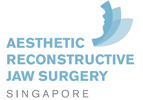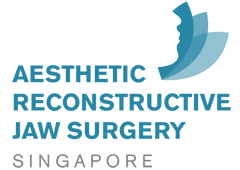Share this
Facial contouring with orthognathic surgery in Singapore
on July 11, 2016

Facial contouring surgery consists of augmentation and reduction of facial bones to change the contours of the face. Augmentation can be achieved by using implants. These implants are screwed onto the underlying facial bone to increase the projection of the face where it is deficient, e.g. a chin implant. Reduction can be achieved by trimming off prominent bony contours with a saw or drill. Orthognathic surgery can be used to achieve both augmentative and reductive results that are more natural and long lasting.
Augmentation by facial implants
There is a wide variety of material used in facial implants. Some are designed to be permanent while others are designed to be replaced over time. The permanent facial implant materials, e.g. porous polyethylene, has a porous structure that allows the body’s own tissue to grow into it and incorporating it within the tissue. Once the tissue has integrated with it, it is very difficult to remove. On the other hand, silicone rubber implants are soft and do not integrate with the tissue, making them easy to change. Depending on the needs of the patient, there are advantages and disadvantages with each type of material. Polyethylene implants are rigid and give a very defined shape. However they are more difficult to place and remove. As such, they are only used in situations where removal or change is not expected in the long run. Silicone implants are easier to place as they are flexible and as such require small incisions to insert them. By not integrating with the tissue, removal and change of size and shape over time is easily done.
Augmentation by bone repositioning
However, for patients who do not want to have facial implants, facial augmentation can also be done by orthognathic surgery. This is done by cutting the facial and jaw bones and repositioning them in a different position. For example, chin augmentation can be done by placing a chin implant or a sliding genioplasty. A sliding genioplasty is done by cutting the chin and sliding it forward to increase the chin projection. The chin is fixed in the new position with plates and screws to allow bony union. Once the bone has healed, the plates and screws are no longer needed and can be remove if the patient desires or be left alone. The repositioned chin is as much a part of the jaw as before and it undergoes the usual bone remodeling process that the rest of the skeleton does. However, it is a more invasive procedure that is usually done under general anesthesia, compared with the a chin implant, which can be done under local anesthesia as an outpatient.
However, not all contouring objectives have both options of either using facial implants or orthognathic surgery. One example is the cheek bone. Typically, Caucasian faces requires cheek augmentation which is usually done by using malar implants. It is possible to do cheek augmentation with orthgnathic surgery but the effects are not as good and the surgery is a lot more invasive. Corrective jaw surgery to increase the cheekbone projection may involve a Le Fort III osteotomy to bring the entire midface together with the cheekbones forward, or a more isolated zygomatic bone surgery. The former requires making an incision through the scalp and pulling it down to expose the floor of the orbits and zygomatic bone for cutting and advancing forward. This is usually reserved for the most severe facial deformities. The latter involves cutting the cheekbone and repositioning it in a different position and then fixing it with plates and screws. Although less invasive then the Le Fort III, it is still a fairly invasive procedure. In view of the higher risks involved cheek bone augmentation for most patients are done using facial implants.
Reductive facial contouring by trimming
This can be done by simply trimming off the excessive part of the facial bone. However, such an approach may result in an uneven surface. In Asian faces, more often than not, facial contouring involves reduction rather than augmentation. The Asian aesthetic preference is for a more rounded facial contour instead of the angular and chiseled look that is popular in the West. The common facial bones that are re-contoured in Asians are the zygoma, the mandibular angles, and the chin.
Reductive facial contouring by bone repositioning
Zygomatic (cheekbone) bone reduction is done via an intraoral incision and a skin incision just in front of the jaw. The zygomatic bone is cut and mobilized, a section of it removed, and the reduced zygoma pushed inwards and downwards and fixed with plates and screws. If the amount of reduction is small, trimming can be done on the surface of the bone instead but this tends to produce a rather uneven surface and is more difficult to achieve symmetry between the left and right sides. Mandibular (lower jaw) angle reduction is done by cutting off the excessively developed angle and removing it altogether. The remaining cut surface is smoothened with burs and rasps to eliminate any sharp angles. This is often combined with a chin reduction to create a V-shaped face.
Combination with double jaw surgery
For those with an anomaly of jaw size, the benefits of the above procedures cannot be fully realized without correcting the jaw size discrepancies. This often involve a double jaw surgery, whereby the jaw bases are corrected into a proper Class I relation with the proper vertical proportions as well. As such, a total facial reconstruction may involve a double jaw surgery together with mandibular angle resection, a genioplasty and a zygomatic bone reduction. Sometimes, it is possible to combine all these procedures together but more often, they are done in a stage fashion to enable the patient to better visualize the degree of change that they want gradually.
Share this
- Jaw Surgery (93)
- Dental Implants Singapore (90)
- Orthognathic Surgery (48)
- Replacing Missing Teeth (26)
- Missing Teeth Options (23)
- Underbite (23)
- Bone Grafting (21)
- Costs (18)
- Facial Aesthetics (18)
- Aesthetics (17)
- dental implants (16)
- corrective jaw surgery (15)
- BOTOX (11)
- Dermal Fillers (11)
- Wisdom teeth (10)
- Fixed Implant Dentures (8)
- Loose Dentures Singapore (6)
- Medisave (6)
- sleep apnea (6)
- Braces (5)
- Dental Pain (5)
- Dentures in Singapore (5)
- Loose Teeth (5)
- Tooth Extraction (5)
- jaw deformities (5)
- bimax (4)
- bone graft (4)
- maxillomandibular advancement (4)
- all-on-4 (3)
- bimaxillary protrusion (3)
- chin implant (3)
- facial asymmetry (3)
- full mouth dental implants (3)
- genioplasty (3)
- immediate implant (3)
- removal of an integrated dental implant (3)
- third molars (3)
- wisdom tooth surgery (3)
- My Dentures Don't Fit (2)
- VME (2)
- bone graft healing (2)
- distraction osteogenesis (2)
- medical tourism (2)
- obstructive sleep apnea (2)
- orthodontics (2)
- plastic surgery (2)
- CT guided dental implants (1)
- Double jaw surgery (1)
- Invisalign (1)
- Periodontal Disease (1)
- Permanent Dentures Singapore (1)
- before and after photos (1)
- facial trauma (1)
- fractured dental implant (1)
- oral appliance therapy (1)
- root canal treatment (1)
- veneers (1)
- vertical maxillary excess (1)
- September 2019 (2)
- July 2019 (2)
- May 2019 (2)
- August 2018 (1)
- October 2017 (1)
- September 2017 (2)
- August 2017 (1)
- June 2017 (2)
- May 2017 (4)
- April 2017 (1)
- March 2017 (1)
- February 2017 (3)
- January 2017 (3)
- December 2016 (1)
- November 2016 (2)
- October 2016 (4)
- September 2016 (9)
- August 2016 (5)
- July 2016 (11)
- June 2016 (14)
- May 2016 (6)
- April 2016 (2)
- March 2016 (1)
- January 2016 (7)
- December 2015 (10)
- November 2015 (4)
- October 2015 (9)
- September 2015 (7)
- August 2015 (1)
- July 2015 (6)
- June 2015 (3)
- May 2015 (7)
- April 2015 (5)
- March 2015 (8)
- January 2015 (5)
- December 2014 (7)
- November 2014 (7)
- October 2014 (6)
- September 2014 (8)
- August 2014 (5)
- July 2014 (7)
- June 2014 (8)
- May 2014 (9)
- April 2014 (10)
- March 2014 (6)
- February 2014 (8)
- January 2014 (3)
Subscribe by email
Email subscription




Comments (2)